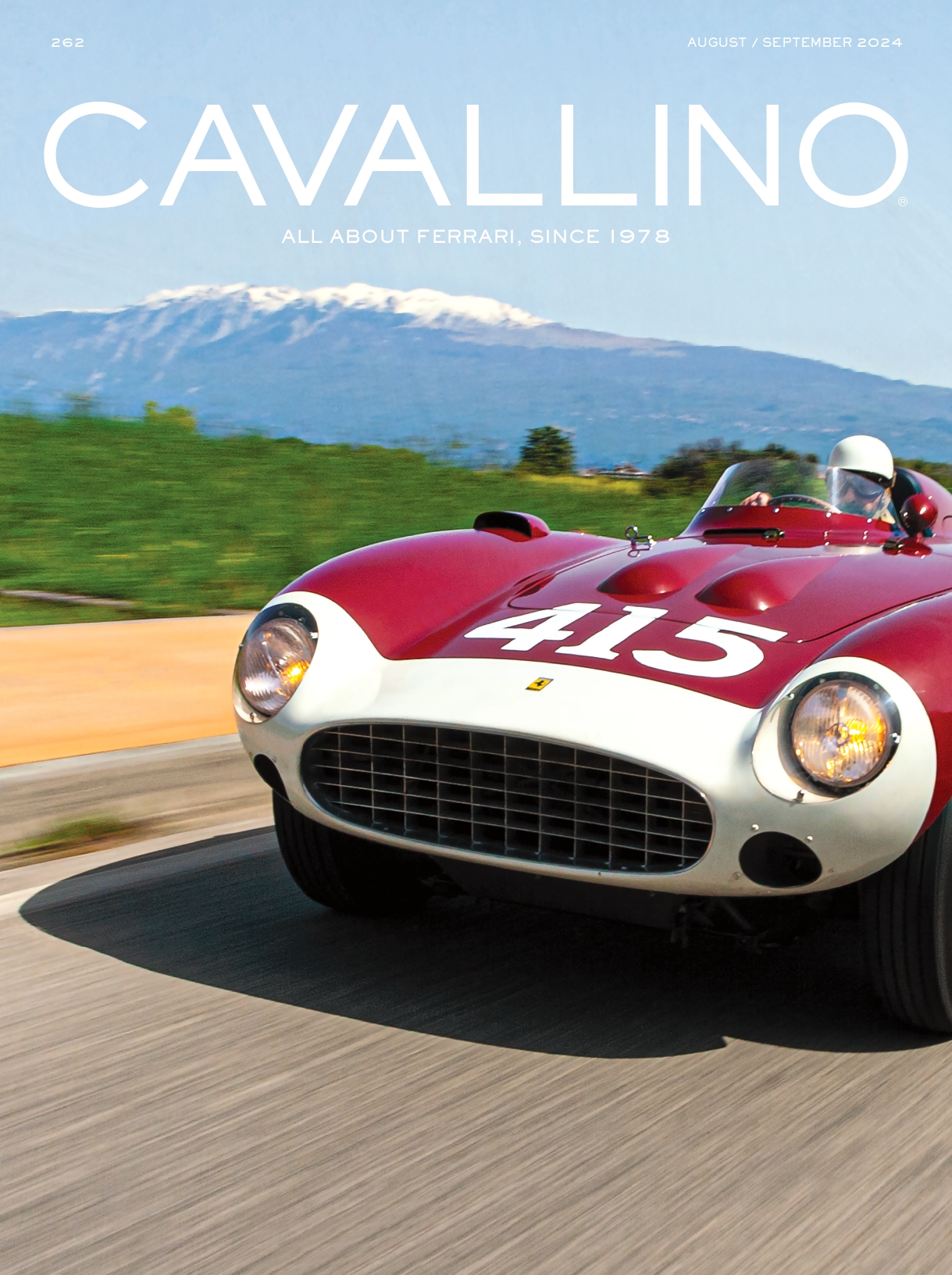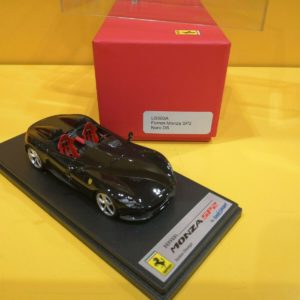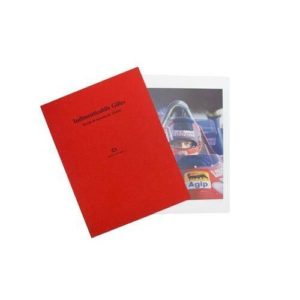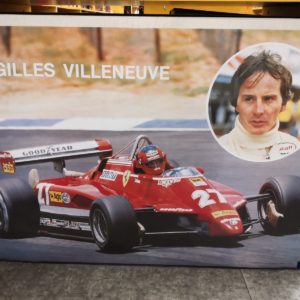Descrizione
Ferrari Cavallino Magazine #262 – August / September 2024
This is very special issue indeed, which includes several features telling the story of Scuderia Ferrari in the pre-war years. One point emerges strongly: without all that happened during those years, Enzo Ferrari would not have been able to embark on his adventure as a manufacturer, as he did in 1947, when he founded Ferrari Automobili.
– Main feature and cover car:
1955 857 S s/n 0203 M, our issue 263 cover car, has an amazing racing history, receiving three chassis numbers during its life as a Scuderia Ferrari works car (originally 0584 M, then 0578 M, and finally its current 0203 M). Its huge historical importance is confirmed, among other things, by the list of top drivers that raced, and won, in it: Umberto Maglioli, Maurice Trintignant, Eugenio Castellotti, Alfonso de Portago, Phil Hill, and Peter Collins. In 1957, through Luigi Chinetti, it was sold to its first private owner, Gene Greenspun of New York, who entered it in the inaugural Sports Car Club of America Grand Prix Sports Car Races at the, then new, Virginia International Raceway, near Danville, VA, close to the North Carolina state border, on August 3-4, 1957. Since 2005 it has been back in Italy, where it was perfectly restored before entering its current ownership in 2010. Despite never racing in the MM, the car sports a Mille Miglia racing number — the one it was assigned for its appearance, just weeks before our shoot, in Michael Mann’s movie Ferrari.
– Profile: 1934 Scuderia Ferrari Alfa Romeo 8C 2300 “Monza” s/n SF 28
Enzo Ferrari founded Ferrari Automobili in 1947. Up until that point, apart from his Auto Avio Costruzioni, which he opened in 1940, his racing world had revolved around Scuderia Ferrari, which competed with Alfa Romeos. From 1929 to 1939, the Scuderia Ferrari Alfas enjoyed an incredible spate of successes, laying the foundations of the Ferrari legend so familiar to us today. Unfortunately, many of the pre-war racing Alfas, amazingly advanced technological artifacts, were lost during the war and the early post-war years, with parts getting separated from the cars and often being lost or run into the ground. The Monza featured in Cavallino was purchased new by Scuderia Ferrari in early 1933 and raced throughout the season. Unfortunately, all the books containing data linking its chassis numbers/drivers/races were lost or destroyed, and so it is almost impossible to accredit specific race results. The car profiled here is known to have been driven to victory by Antonio Brivio in the Swedish GP on August 6, 1933, before being modified by Ferrari. On that occasion, then, it still bore its original Alfa Romeo serial number, 2211120 (with its Modena registration plate, MO 6608). Subsequently, after being modified and assigned s/n SF 28, it was entrusted, by Scuderia Ferrari, to the duo Pietro Ghersi and Gugliemo Carraroli, and assigned MM race number 58. They retired from the MM on the leg to Venice when running sixth, after being second fastest on the 226-km Siena-to-Rome leg. Several races followed, including a Targa Florio, before the car was sold and transformed into a fast road car. It ended up in South Africa, where it kept on club racing, and was also used as a sort of daily runaround for several years, miraculously surviving a crash in 1968. Back in Europe it was meticulously restored, before entering a Swiss collection in 2020 where it still remains. It is often used by its current owner.
– Focus On, devoted to the short and happy life of Scuderia Ferrari from 1929 to 1939, describes the origins and the most crucial strategies and people (from managers to racers) from what proved to be truly amazing years for Enzo Ferrari and his newly established company. Over a period of eight racing years, Scuderia Ferrari took part in 225 races with a total of 715 cars, recording 144 victories and another 171 podium finishes. The people of that period were instrumental in the success of the Scuderia, but most of them remained very important in the post-war years, too, with many of them entering Ferrari Automobili. One name above all? Tazio Nuvolari…
– One off takes a close look at Officine Reggiane, the little-known Reggio Emilia factory that was fundamental in the birth of what we today call “Motor Valley”. If you have ever wondered how lightweight material expertise first came to Emilia, the Officine Reggiane story will tell you. As part of the WWII effort, this company began manufacturing airplanes, but at the end of the war, it was almost completely shut down. Of the hundreds, if not thousands, of people who left Reggiane equipped with immense knowledge and know-how, some entered a new company, named Ferrari Automobili, situated just a few kilometers away. They include some very famous names: Aurelio Lampredi, considered the father of the 4.5-liter 12-cylinder engine, Walter Salvarani, who would design the F1 chassis for the 156, and Franco Rocchi, who with Mario Forghieri, created the Formula 1 312 T.
We also celebrate 70 years of Ferrari North America, looking at its history from the early years, under Luigi Chinetti, to its more modern years under the guidance of Matteo Torre, president since 2017. Luigi Chinetti had moved to the USA to escape WWII. After importing Ferraris into the USA for six years on casual basis (thanks to his friendship with Enzo Ferrari), in 1954 he became official Ferrari importer for the area stretching from the Atlantic Coast to the Rocky Mountains, opening Luigi Chinetti Motors on West 55th Street in Manhattan. He subsequently moved the store to West 19th Street, then 11th Avenue, before finally leaving for fertile territory in Greenwich, Ct. in 1966. In 1957, Johnny von Neumann, the west-coast racer, opened a dealership in Hollywood. This was shortly followed by hotel and casino magnate Bill Harrah’s Modern Classic Motors in Reno, Nevada. Contemporary Ferrari North America was founded as a subsidiary of Ferrari SpA in 1990, and moved to its current home in Englewood, N.J., just in time for a Ferrari revival and to see Gianni Agnelli appoint Luca di Montezemolo as president and chairman in 1991. The U.S. Ferrari Challenge, today perhaps the world’s most successful single-make series, followed in 1993 via the 348. Ferrari North America’s current years, and its future, are described by Matteo Torre himself, who told Cavallino “We’re very good at delivering beautiful cars, but performance is the center of the product strategy,” and “We have a legacy to respect, but it’s an accelerator to innovation.”
– Corsa focuses on races 6 to 9 in the 2024 F1 season, including the Monte Carlo victory, and races 3 and 4 in the WEC, reporting on the victory at the 24 Hours of Le Mans.
– Eventi focuses on the 4th Cavallino Classic Modena, held in the city of Enzo Ferrari’s birth. A limited number of selected cars, a delightful setting, and the right crowd confirmed this as one of the most amazing car events. Added bonuses were the parade in downtown Modena and, probably one of this year’s highlights, the stop at the Ferrari Museum in Modena, the actual house where Enzo Ferrari was born. Other events covered are the Concorso di Eleganza di Villa d’Este and the always fascinating Grand Prix Classic of Monaco.
Finally, as always, Cavallino brings you the voices of several editorialists, discussing a variety of topics, as well as a full and updated list of Ferrari market values (also of the latest models) compiled by specialists analyzing the values and market trends of different Ferrari cars.





